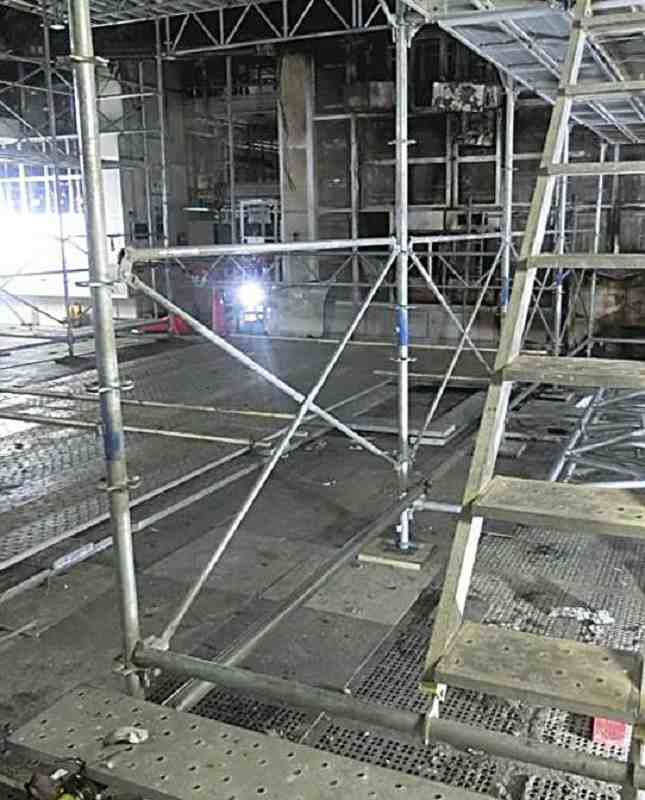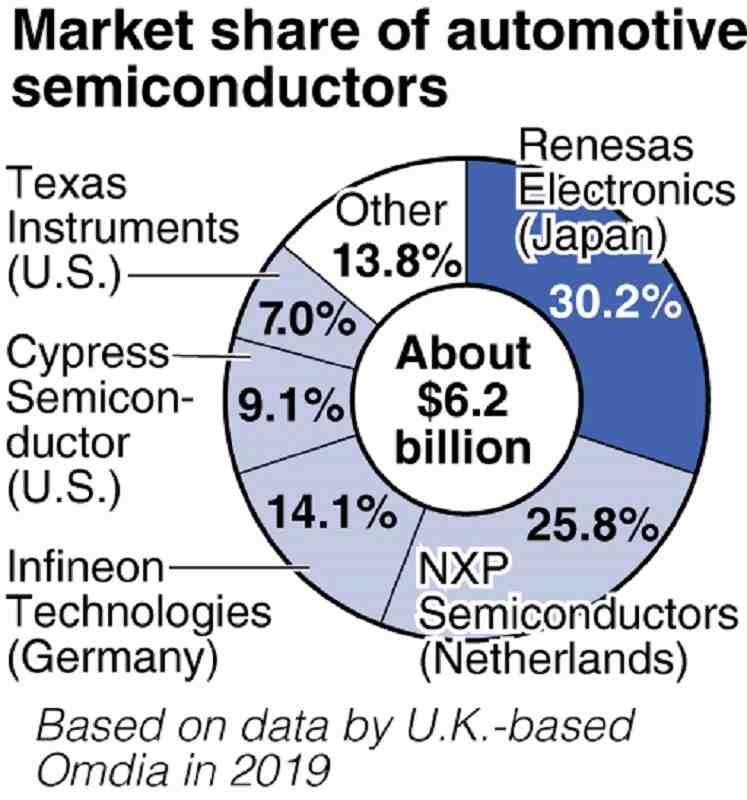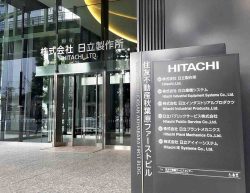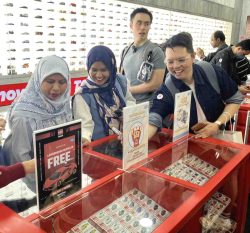
Damaged machinery has been removed from the building as seen in this March 30 photo.
11:58 JST, April 3, 2021
Shipment volumes from Renesas Electronics Corp.’s Naka plant are unlikely to return to normal until summer, after the plant suspended operations due to a fire. Japanese automakers rely heavily on semiconductors manufactured by Renesas, and the blaze is highly likely to force carmakers to reduce production further. Many players, including the government, are working together to minimize the impact of the fire.

One-month vacuum
“I sincerely apologize to residents near the plant, our customers and others for all the trouble caused by the fire,” said Renesas Electronics President Hidetoshi Shibata during a virtual press conference on Tuesday.
The blaze happened when stock volumes at the Naka plant, located in Hitachinaka, Ibaraki Prefecture, were already low due to power outages triggered by an earthquake that occurred off neighboring Fukushima Prefecture in February.
The company is shipping the untainted remaining stock from the “N3 building” where the conflagration occurred so that production at automakers will not be affected. However, the stock is expected to run out in late April.
Renesas aims to resume operations around that time.
For unfinished products not affected by the fire, the company will complete production and ship them sequentially, tentatively scheduled for late May. Therefore, a monthlong gap in shipments is expected.
Semiconductor production takes about three months from processing raw materials to shipping finished products.
Semiconductors are used in a variety of automotive equipment, such as the power steering that helps drivers steer a vehicle, air conditioners, air bags, car navigation systems and window opening and closing systems. About 30-40 semiconductors are needed to produce a single gasoline-powered car.
Automakers maintain stock of semiconductors, but they will be forced to stop production if they run out.
All hands on deck
Renesas is the world’s top manufacturer of automotive semiconductors, which are used in a vehicle’s electronic control systems and for other purposes. At the Naka plant, more than 60% of the semiconductors produced are destined for the automotive sector.
An increasing number of automakers are reducing production and suspending plant operations due to a global shortage of semiconductors.
The Naka plant fire will deal yet another blow to the industry.
Mitsubishi UFJ Morgan Stanley Security Co. has forecast that, even if the Naka plant restarts production in April, domestic automakers such as Toyota Motor Corp., Honda Motor Co. and Nissan Motor Corp. will cut production by 1.65 million units in total from April to September.
After reconstructing the building, Renesas will endeavor to resolve supply shortages that are expected to run through the summer and possibly beyond.
Automakers understand that a quick reconstruction of the Renesas plant will help ease the situation, and several dispatched workers to assist the company soon after the fire was extinguished. More than 900 such personnel are working to get the plant functioning again, such as by repairing the clean room area where the blaze started.
Request to Taiwan
The government has started taking measures due to concerns that the semiconductor shortage could hinder an economy starting to recover from the ravages of the coronavirus pandemic.
“We’ve asked a Taiwanese chipmaker for cooperation to produce semiconductors on behalf of Renesas as this is an emergency situation,” Economy, Trade and Industry Minister Hiroshi Kajiyama said at a press conference after a Cabinet meeting on Tuesday.
Most semiconductors are produced by contract manufacturers that receive designs from semiconductor makers and then assemble the units. Due to the global shortage of semiconductors, it was not believed that Renesas would manage to increase the number of such contractors.
“External partners are producing semiconductors for us. Such production would have been unthinkable under ordinary circumstances,” Renesas’ Shibata said.
However, it is unclear if this strategy will help increase supplies in Japan given the tight supply-demand balance in the semiconductor world.
"Business" POPULAR ARTICLE
-

Keidanren Chairman Yoshinobu Tsutsui Visits Kashiwazaki-Kariwa Nuclear Power Plant; Inspects New Emergency Safety System
-

Tokyo Economic Security Forum to Hold Inaugural Meeting Amid Tense Global Environment
-

Imports of Rare Earths from China Facing Delays, May Be Caused by Deterioration of Japan-China Relations
-

University of Tokyo Professor Discusses Japanese Economic Security in Interview Ahead of Forum
-

Japan Pulls out of Vietnam Nuclear Project, Complicating Hanoi’s Power Plans
JN ACCESS RANKING
-

Keidanren Chairman Yoshinobu Tsutsui Visits Kashiwazaki-Kariwa Nuclear Power Plant; Inspects New Emergency Safety System
-

Tokyo Economic Security Forum to Hold Inaugural Meeting Amid Tense Global Environment
-

Imports of Rare Earths from China Facing Delays, May Be Caused by Deterioration of Japan-China Relations
-

University of Tokyo Professor Discusses Japanese Economic Security in Interview Ahead of Forum
-

Japan Pulls out of Vietnam Nuclear Project, Complicating Hanoi’s Power Plans

























